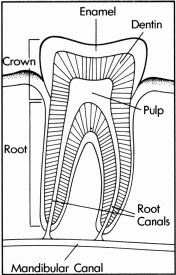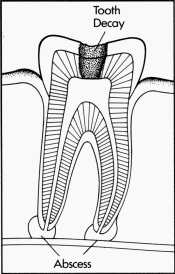|
Your teeth are meant to last a lifetime. Even if one
of your teeth becomes injured or diseased, it often can be saved through
root canal (endodontic) treatment. To help you understand this procedure,
we have answered some often asked questions about this treatment.
Diagram of a healthy tooth.

What is the dental pulp?
The pulp is the soft tissue that contains nerves, blood vessels and
connective tissue. It lies within the tooth and extends from the crown of
the tooth to the tip of the root in the bone of the jaws.
top
What happens if the pulp gets injured?
When the pulp is diseased or injured and can't repair
itself, it dies. The most common cause of pulp death is a
cracked tooth or a deep cavity. Both of these problems can
let germs (bacteria) enter the pulp. Germs can cause an
infection inside the tooth. Left without treatment, pus
builds up at the root tip, in the jawbone, forming a
"pus-pocket" called an abscess. An abscess can
cause damage to the bone around the teeth.
top
An abscessed (infected)
tooth caused by tooth decay.
 Why does the pulp need to be removed? Why does the pulp need to be removed?
When the infected pulp is not removed, pain and
swelling can result. Certain byproducts of the infection
can injure your jaw bones. Without treatment, your tooth
may have to be removed.
top
What
is root canal treatment?
Your dentist uses root canal treatment to find the cause and then treat
problems of the tooth's soft core (the dental pulp). Years ago, teeth with
diseased or injured pulps were removed. Today, root canal treatment has
given dentists a safe way of saving teeth.
top
What does treatment involve?
Treatment often involves from one to three visits.
During treatment, your dentist removes the diseased pulp.
The pulp chamber and root canal(s) of the tooth are then
cleaned and sealed.
top
Why do I need root canal treatment?
Root canal treatment can help save your damaged tooth. When the pulp
(the soft tissue inside the tooth that contains nerves and blood and
lymph vessels) is diseased or injured and unable to repair itself, the
pulp dies. The most common cause of pulp death is a fractured tooth or
a deep cavity, which can expose the pulp to the bacteria found in
saliva. The bacteria cause infection inside the tooth. If the damaged
or diseased pulp is not removed, the tooth and surrounding tissues
become infected. Without treatment, your tooth could eventually have
to be removed. If the problem is caught early enough, however, your
dentist can save your tooth using root canal treatment.
top
Why did I get an abscess?
When the pulp of a tooth becomes infected (often from a deep cavity
or a deep crack), the infection can spread throughout the pulp. If
root canal treatment is not done, the infection may travel into the
tissues near the root tip. This can cause the adjacent bone to erode.
The pocket of pus that forms is the abscess. If the abscess increases
in size, it can become more painful.
top
How long will the restored tooth last?
Your restored tooth could last a lifetime, if you
continue to care for your teeth and gums. However, regular checkups
are necessary. As long as the root(s) of a treated tooth are nourished
by the tissues around it, your tooth will remain healthy.
top
| ![]()